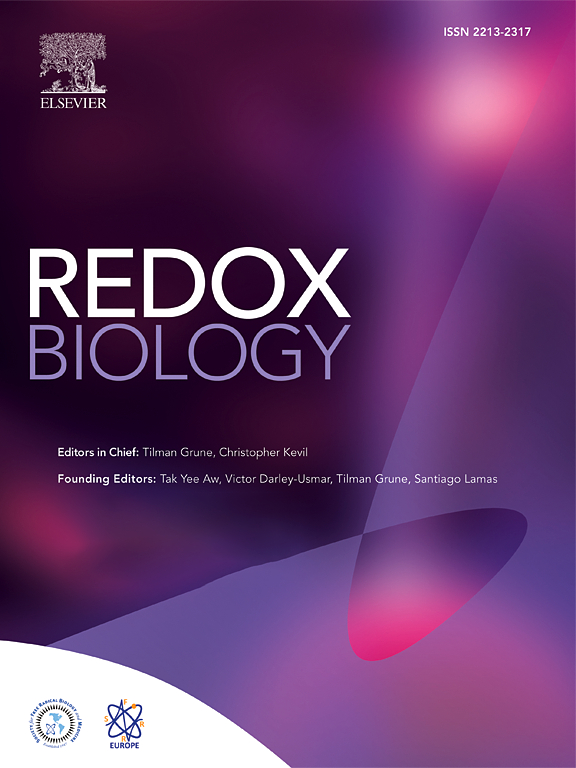Gaylussacin,一种二苯乙烯糖苷,抑制小鼠慢性阻塞性肺疾病
IF 11.9
1区 生物学
Q1 BIOCHEMISTRY & MOLECULAR BIOLOGY
引用次数: 0
摘要
慢性阻塞性肺疾病(COPD)是全世界人类死亡的一个主要原因,与铅(Pb)和镉(Cd)等环境毒物引发的慢性炎症密切相关。然而,将Pb/Cd暴露与COPD发病机制和有效治疗策略联系起来的分子机制仍不明确。在这项研究中,我们通过使用专门的雾化器系统将小鼠暴露于Pb/Cd气溶胶中,建立了环境诱导的COPD小鼠模型。Pb/Cd暴露导致典型的copd样病理特征,包括肺泡损伤、粘液分泌过多、氧化应激和细胞凋亡。肺组织转录组分析显示,促炎细胞因子、趋化因子和脂质代谢相关基因上调,巨噬细胞,特别是表达mmp -12的巨噬细胞,被认为是肺部炎症的关键因素。通过靶向二苯乙烯类化合物筛选,我们发现gaylussacin可以有效抑制Pb/ cd诱导的巨噬细胞中MMP-12的表达。从机制上讲,gaylussacin通过激活SIRT1抑制MMP-12和炎症介质的表达。在猪胰腺弹性酶(PPE)诱导的肺气肿模型中,口服gaylussacin可显著改善肺功能,减少细胞凋亡、ROS产生和炎症。药代动力学分析显示,gaylussacin的口服生物利用度有限,但能有效地转化为其活性代谢物pinosylic酸。毒理学评估证实,对来自不同器官的正常细胞的毒性可以忽略不计,在体内没有明显的不良反应。总的来说,这些研究结果表明,Pb/Cd吸入通过MMP-12介导的巨噬细胞驱动的炎症促进COPD的发病,而gaylussacin通过增强SIRT1活性来减轻这些影响。这项研究支持gaylussacin作为一种有希望的治疗候选者用于治疗环境诱导的COPD。本文章由计算机程序翻译,如有差异,请以英文原文为准。
Gaylussacin, a stilbene glycoside, inhibits chronic obstructive pulmonary disease in mice
Chronic obstructive pulmonary disease (COPD) is a major cause of human mortality worldwide and is closely associated with chronic inflammation triggered by environmental toxicants such as lead (Pb) and cadmium (Cd). However, the molecular mechanisms linking Pb/Cd exposure to COPD pathogenesis and effective therapeutic strategies remain poorly defined. In this study, we established a mouse model of environmentally induced COPD by exposing mice to Pb/Cd aerosols using a specialized nebulizer system. Pb/Cd exposure led to characteristic COPD-like pathological features, including alveolar damage, mucus hypersecretion, oxidative stress, and apoptosis. Transcriptome analysis of lung tissues revealed upregulation of pro-inflammatory cytokines, chemokines, and lipid metabolism–related genes, with macrophages–particularly those expressing MMP-12–identified as key contributors to pulmonary inflammation. Through a targeted stilbenoid compound screen, we identified gaylussacin as a potent suppressor of Pb/Cd-induced MMP-12 expression in macrophages. Mechanistically, gaylussacin suppressed expression of MMP-12 and inflammatory mediators via activation of SIRT1. In a porcine pancreatic elastase (PPE)-induced emphysema model, oral administration of gaylussacin significantly improved lung function, reduced apoptosis, ROS production, and inflammation. Pharmacokinetic analysis revealed limited oral bioavailability of gaylussacin but efficient conversion to its active metabolite, pinosylvic acid. Toxicological evaluations confirmed negligible toxicity in normal cells derived from various organs and no significant adverse effects in vivo. Collectively, these findings demonstrate that Pb/Cd inhalation promotes COPD pathogenesis through macrophage-driven inflammation mediated by MMP-12 and that gaylussacin mitigates these effects by enhancing SIRT1 activity. This study supports gaylussacin as a promising therapeutic candidate for the treatment of environmentally induced COPD.
求助全文
通过发布文献求助,成功后即可免费获取论文全文。
去求助
来源期刊

Redox Biology
BIOCHEMISTRY & MOLECULAR BIOLOGY-
CiteScore
19.90
自引率
3.50%
发文量
318
审稿时长
25 days
期刊介绍:
Redox Biology is the official journal of the Society for Redox Biology and Medicine and the Society for Free Radical Research-Europe. It is also affiliated with the International Society for Free Radical Research (SFRRI). This journal serves as a platform for publishing pioneering research, innovative methods, and comprehensive review articles in the field of redox biology, encompassing both health and disease.
Redox Biology welcomes various forms of contributions, including research articles (short or full communications), methods, mini-reviews, and commentaries. Through its diverse range of published content, Redox Biology aims to foster advancements and insights in the understanding of redox biology and its implications.
 求助内容:
求助内容: 应助结果提醒方式:
应助结果提醒方式:


